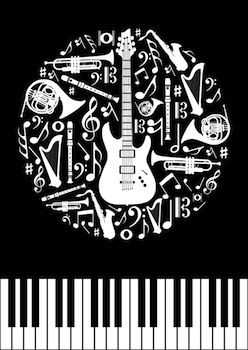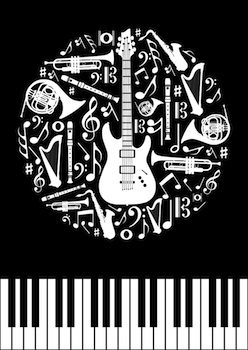 Today we welcome Joseph Pingel of Keyed Up Piano to share his journey of playing by ear, and how he transformed his guitar skills to learn to play piano music by ear.
Today we welcome Joseph Pingel of Keyed Up Piano to share his journey of playing by ear, and how he transformed his guitar skills to learn to play piano music by ear.
At age 16, I taught myself how to play by ear on the piano. After a couple years, reality sunk in that standard piano lessons were never going to teach me that elusive skill. Quitting lessons ended one era of my training and started another.
Outside-the-box-thinking turned up a solution to playing the piano by ear on my own. It was a natural progression for which I had one great advantage that gave focus to my goal.
I Could Play The Guitar
Experience on the guitar was my ticket to becoming a self-taught pianist. It was evident that chords were the key to playing guitar and thus—I figured—the piano as well. The transition was seamless because I already knew a lot of songs that easily transferred from guitar to the piano.
You might wonder “Could it be that easy?” In part, yes. For me, knowing chords was the root of “playing by ear.”
However I hadn’t considered one very important thing: perhaps the one most important overlooked aspect of the skill.
Ear Training Was Not The Issue

The idea of training your ear to hear different tones and intervals never occurred to me. I was a natural and already knew how to play by ear before I learned chords on the piano. Though the guitar and piano are different instruments, the play-by-ear ability is the same for both.
Without a need to tune my ear, my “play-by-ear” concentration turned to everything else that ruled that skill. My attention focused on chords, numbers and the simplicity of thinking; the ability to apply one’s best choices to keep track of where you are and where you are going. Mind over matter.
Two Opposite Approaches To Playing By Ear
I’d been aware of “ear training” for a while but never gave it serious thought until discovering Christopher Sutton’s Easy Ear Training website. I contacted him immediately. It seemed so strange how two people could come to the same end (playing by ear) by approaching the subject from completely different directions. It was fascinating and I started exploring his methods and thinking.
I Discovered Some Things That Blew My Mind
My greatest change in thinking came after an intense discussion with a good friend that added another perspective to the subject.
He talked about the trouble some highly trained and experienced musicians have developing their ear to hear tones properly. He discussed at length three things that he considered “common” scenarios:
- When given a specific tone to find on the piano, some people cannot recognize the tone unless someone tells them “that’s it.”
In other words, they can be in complete unison with a tone and still not recognize it. - Some people cannot determine whether a melody goes up or down with their ear (even with simple songs like Mary Had a Little Lamb).
Further, this form of “tone-deafness” is just as common to advanced musicians as it is with beginners. - Lastly, he told a story of a girl who could sing fine provided the musicians conformed to her key. However, if the band raised the key up or down a half-step, she couldn’t find the right notes or effectively “calibrate” her voice to the altered key.
So Really, What Is Playing By Ear?
This is the million-dollar question. Clearly, it’s not just one thing, but rather a multifaceted skill that is made up of two basic abilities:
- Ear training (either learned or natural); and
- Specific knowledge of music theory that gives one their best choices of chords, progressions and reflex-fingering movements that fit a particular melody.
In addition to those things, experience and natural talent are also part of the mix.
Not All Play-By-Ear Musicians Have These Skills
For example, when I downloaded the RelativePitch app and tested myself, I was very surprised to discover that I couldn’t identify the intervals consistently. Yet, I can hear the intervals in my head and find the right chords on-the-fly without any problem. I also have an uncanny ability to hum a song simply by looking at the sheet music.
Fascinating…










awesome